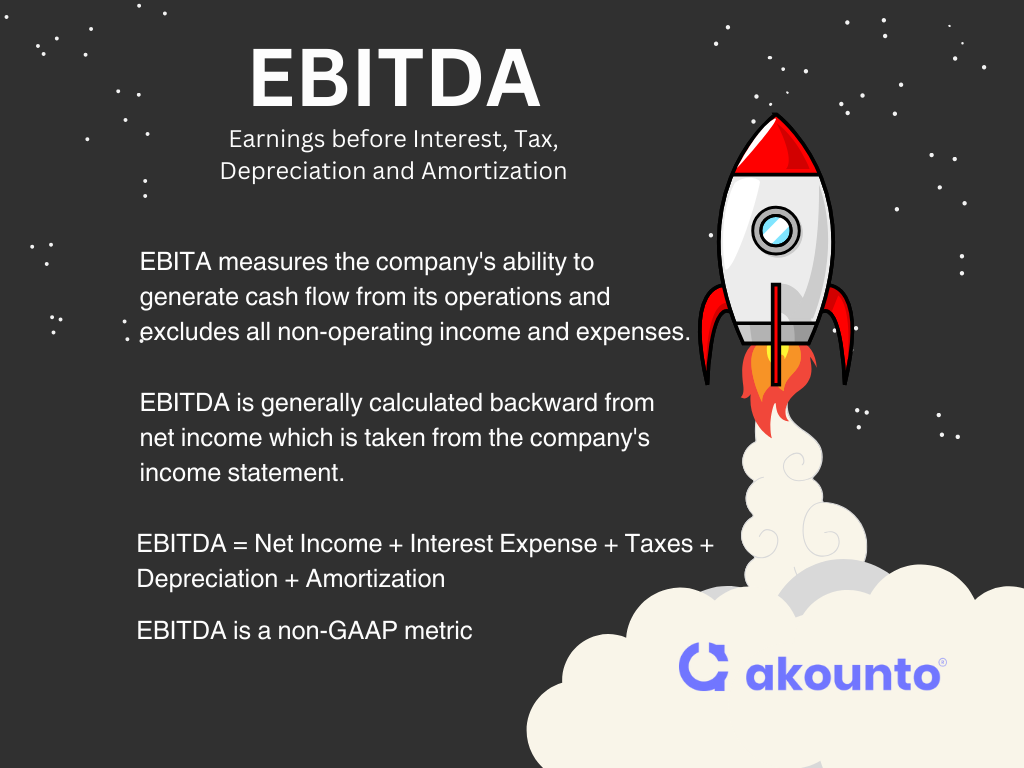Company’s EBITDA measures operating profitability and helps in company valuation, investor analysis, and comparison within the same industry.
EBITDA stands for earnings before interest, taxes, depreciation, and amortization and is generally calculated backward from net income which is taken from the company’s income statement.
EBITA measures the company’s ability to generate cash flow from its operations and excludes all non-operating income and expenses. Non-operating expenses can be cash-based, like interest and income tax, or they can also be non-cash, like depreciation and amortization expenses.
A company’s financial performance generally includes all types of income and expenses, including operating income, i.e., income from business operations, and non-operating income, such as income from asset sales, investments, restructuring, legal settlements, etc.
Similarly, the expenses also include operating expenses, i.e., expenditures related to core business operations, and non-operating expenses like interest, restructuring charges, impairment charges, etc.
Non-operating income and expenses within the same industry vary from company to company depending on management’s decision-making. However, they drastically alter the company’s financial statements.
EBITDA excludes all non-operating income and expenses and assesses a company’s operating expenses in relation to its operating income, which directly affects the cash flow statement. Thus, it enables comparison of companies’ financial statements within the same industry.
EBITDA is one of the most used profitability metrics for comparing different companies, calculating enterprise value, analyzing operating profit, and making investment decisions.
EBITDA is often used as a substitute for operating cash flow, i.e., cash flow generated by a company from its core business operations; thus, EBITDA excludes non-cash expenses.

Rationale for Excluding Depreciation and Amortization from EBITDA
Depreciation expense is the charge for the wear, tear, and obsolescence of tangible assets of the company. While amortization expense is similar to depreciation, it is linked to the intangible assets.
Amortization factors in the reducing value of intangible assets. In both depreciation and amortization, the cost of tangible and intangible assets is spread over their useful lives.
In a company’s income statement, the net income is derived by subtracting interest, taxes, depreciation, and amortization expenses.
Depreciation and amortization are decided by the company’s accounting policies, which are at the discretion of the management. Additionally, depreciation and amortization are non-cash expenses. Thus, they do not directly affect the cash flow statement of a company.
EBITDA excludes depreciation and amortization, removing the impact of non-cash and non-operating expenses and allowing operating income to be derived to assess the company’s operating efficiency.
Rationale for Excluding Interest and Taxes from EBITDA
The debt-equity mix represents a company’s capital structure. Capital structure means the composition of a company’s capital, which is used to run business operations. A company can choose between debt financing, equity financing, or a mix of the two.
Equity or debt financing involves paying for these sources of funds. For equity, the company pays through dividends, and for debt financing, the company incurs interest expense.
Interest expense is dependent upon the debt and the interest negotiated between the company and its creditors. This negotiation is different for different companies, and interest expense is not directly linked to the company’s core business operations. Thus, EBITDA also excludes interest expense to gain parity and enable comparison between companies.
A company’s income tax is dependent on the profits it generates, deferred taxes, dependent on firm status, turnover, jurisdiction (tax rate), and many other factors that also include non-operational aspects like income from any legal settlement, income from royalties, etc. Thus, the income reported in the income statement includes operational and non-operational revenue sources.
Though income tax expense is shown in a company’s cash flow statement under the head of “operating activities”, EBITDA excludes income tax due to tax variability, focusing on cash generation from core business operations, analytical simplicity, and discarding any factor that is beyond company’s control and operations in generating revenue from operations.
EBITDA and a Company’s Net Income
EBITDA and net income are both measures of profitability but show different aspects despite both being shown in a company’s income statement.
Usually, EBITDA is back-calculated from net income; thus, EBITDA (earnings before interest, taxes, depreciation, and amortization) excludes all non-cash and non-operating expenses.
Net income (bottom line) shows a company’s overall financial performance, while EBITDA only focuses on operating profit and eliminates the impact of non-cash expenses (depreciation and amortization) and non-operating expenses (income tax and interest expense).
Net income is based on the accrual basis of accounting and includes income earned but not yet received (accrued revenue); thus, net income does not reflect the complete impact on the cash flow statement. EBITDA focuses only on the operating cash flow for a given accounting period, thus highlighting debt servicing capacity in addition to liquidity and sustainability.
EBITDA Margin
EBITDA margin is the percentage of cash from operations w.r.t. its total revenue. It shows the percentage of a company’s profitability derived from its core business operations.
EBITDA margin is the cash profit before incurring any capital expenditures, paying interest expenses, taxes, and other non-cash payments. EBITDA margin shows the impact of operating expenses on gross profit.
Higher the EBITDA margin, lower its operating expenses. Low EBITDA margin reflects issues with the company’s profitability. EBITDA margins are used in mergers and acquisitions, valuation of marketable securities, and comparing ROI.
EBITDA margin is not GAAP (Generally Accepted Accounting Principles) recognized metric and should not be applied to companies that are leveraging on debt or have high debt capitalization.
Formula for EBITDA Margin
EBITDA Margin = (EBITDA/ Total Revenue) X 100
EBITDA Calculation
Income Statement Template for EBITDA
| Revenue | XXXX | |||
| COGS | (-) xxx | |||
| Gross Profit | XXXX | |||
| Marketing & Sales | (-) xxx | |||
| Office & Admin Expenses | (-) xxx | |||
| EBITDA | (Gross Profit – Operational Cost) | XXXX | ||
| Depreciation | (-) xxx | |||
| Amortization | (-) xxx | |||
| EBIT (Operating Profit) | (EBITDA – Dep – Amortization) | XXXX | ||
| Interest | (-) xxx | |||
| PBT | (EBIT – Interest) | XXXX | ||
| Taxes | (-) xxx | |||
| Net Profit (PAT) | (PAT = PBT – Tax) | XXXX |
EBITDA Formula
Case 1: Calculating EBITDA from Net Income
EBITDA = Net Income + Interest Expense + Taxes + Depreciation + Amortization
Case 2: Formula to Calculate EBITDA from Revenue
EBITDA = Revenue – Operating Expenses – Depreciation – Amortization
Case 3: Formula to Calculate EBITDA from EBIT
EBITDA = EBIT + Depreciation and amortization
Example of EBITDA Calculation
| Company A | Company B |
| Net Income: $800,000Interest Expense: $100,000Taxes: $200,000Depreciation: $150,000Amortization: $50,000Revenue: $2,500,000Operating Expenses: $1,400,000EBIT (Operating Profit): $900,000 | Net Income: $1,200,000Interest Expense: $150,000Taxes: $300,000Depreciation: $200,000Amortization: $70,000Revenue: $3,000,000Operating Expenses: $1,600,000EBIT (Operating Profit): $1,000,000 |
Compare the companies using EBITDA Metric.
| EBITDA Calculation | ||
| Formula | Company A | Company B |
| Net Income + Interest Expense + Taxes + Depreciation + Amortization | $800,000 + $100,000 + $200,000 + $150,000 + $50,000 | $1,200,000 + $150,000 + $300,000 + $200,000 + $70,000 |
| EBITDA | $1,300,000 | $1,920,000 |
| Revenue – Operating Expenses – Depreciation – Amortization | $2,500,000 – $1,400,000 – $150,000 – $50,000 | $3,000,000 – $1,600,000 – $200,000 – $70,000 |
| EBITDA | $900,000 | $1,130,000 |
| EBIT + Depreciation + Amortization | $900,000 + $150,000 + $50,000 | $1,000,000 + $200,000 + $70,000 |
| EBITDA | $1,100,000 | $1,270,000 |
Based on the calculations using all three formulas, Company B demonstrates better operational efficiency compared to Company A. Across the various methods of calculating EBITDA, Company B consistently shows higher values, indicating stronger profitability from its core business operations.
This suggests that Company B may be managing its resources more effectively and generating higher earnings relative to its operating expenses, depreciation, and amortization.
What’s excluded in adjusted EBITDA?
Cash inflows of any business are dependent on the CapEx (Capital Expenditure) undertaken to generate more revenue, in addition to the changes in working capital.
EBITDA, which helps compare the operational efficiency of even unrelated businesses, can be hampered due to exceptional or one-time transactions such as a major legal settlement, charitable contributions, goodwill impairment, inventory loss writing, or any such exceptional circumstances that happen rarely.
In such a scenario EBITDA gets distorted and must be adjusted against such exceptional financial events. The aim is to get a truer picture of the company’s operating performance, thus we get adjusted EBITDA or EBITDA before exceptionals.
Use Cases of EBITDA
Comparison
EBITDA provides a common comparison ground in terms of an operating performance focusing only on the profits generated by a company’s operations. EBITDA excludes both cash and noncash expenses under non-operating expenses for example, taxes, depreciation, and amortization expenses.
Company Valuation
Company valuation determines a company’s net worth or economic value. It is a part of corporate finance and investment analysis. Factors that help determine a company’s value are its financial performance, future prospects, market conditions, and industry growth benchmarks.
EBITDA helps calculate the enterprise value for both public and private companies. A company’s EBITDA multiple on a stock exchange represents its relative valuation.
Financial Modeling
Financial modeling involves building mathematical models to forecast a company’s future growth, earnings, cash flow situation, and financial performance. An analyst may use historical data, assumptions, valuation, sensitivity analysis, etc., to build a financial model. It is used in corporate finance, equity research, investment banking, etc.
EBITDA and its CAGR can be applied to forecast future cash flow earnings. Financial modeling extensively uses EBITDA as one of the profitability metrics to gauge operational efficiency vis a vis market valuation, determining net worth. Thus, it is also useful in investment banking.
Underwriting
In corporate finance, underwriting assesses the risks involved with a firm’s marketable securities. The underwriter assesses the overall financial health, creditworthiness, going concern, and value of securities issued by a company.
EBITDA is directly linked to operating cash flow and helps analysts gauge a company’s creditworthiness with respect to its debt servicing capability.
Loan Processing
Banks and credit unions use EBITDA to measure a firm’s debt service coverage ratio before disbursing business loans. It acts as a surety of payment and an enhanced measure of creditworthiness.
Debt service coverage ratio is the number of times the operating income of a company can cover its debt.
Investor Analysis
Private equity investors and fund houses use EBITDA to compare companies and make investment choices. While other metrics like debt-to-equity ratio, P/E ratio, and dividend distribution history are also taken into consideration, EBITDA margin is also used to see the efficiency of funds employed regarding Return on investment (ROI) and return on assets (ROA).
What Can You Do to Increase Company EBITDA?
Increasing a company’s EBITDA means to focus on 3 things:
- Enhancing operational efficiency.
- Increasing profitability.
- Increasing earnings from business operations
Enhance operational efficiency by minimizing unnecessary business expenses, employing cost-saving initiatives, using lean inventory management strategies, minimizing burden costs, optimizing the working capital cycle, leveraging technology, automation, and more.
For increasing the profitability, a company can focus on increasing gross margins, focus on pricing strategies, reducing cost of production, taking advantage of business trends, offer value added services, etc.
Increase your earnings from business operations with strategies related to targeted marketing campaigns, divesting non-core assets, bringing down cost of capital by debt restructuring, expanding into new markets, focusing on customer retention, etc.
Pros and Cons of EBITDA
Pros
EBITDA focuses on operating efficiency and thus takes into account only those factors that are related to running day-to-day business operations. EBITDA operating income helps investors to assess the company’s performance without any impact of interest payments, tax expense, and non cash expenses.
Nonoperating expenses vary each year and some are discretionary in nature. By eliminating the nonoperating factors, EBITDA provides a predictable and stable measure of a company’s performance.
EBITDA enables company comparison in the same industry, even though the company’s net income varies drastically. It strips down the financials to its core business operations, thereby giving a common ground for comparison.
EBITDA multiple, also known as the EBITDA to enterprise value ratio binds EBITDA to the company’s valuation and helps in comparable company analysis (CCA) and precedent transaction analysis (PTA) to enable fair valuation for mergers and acquisitions.
EBITDA highlights a company’s financial health and cash flows in terms of business sustainability and self-reliance on core business operations, thereby providing an assessment basis for leveraged buyouts.
Cons
EBITDA excludes interest expenses and tax payments, which are actual cash outflows and reduce the company’s cash corpus. By excluding these expenses, EBITDA fails to show the impact on a company’s financial health.
Cost of borrowing funds and tax payments differ from company to company but impacts the overall financial structure of the company. By ignoring them, a company’s EBITDA oversimplifies financial data for the sake of comparison, which is not true but a subjective choice.
EBITDA ignores the company’s CapEx (capital expenditures); thus, in such a scenario, it cannot depict long-term sustainability and future financial performance.
EBITDA is a Non-GAAP measure and can be easily manipulated by aggressive revenue recognition, excluding exceptional but major expenses during an accounting year, asset valuation, changes in accounting policies, decreasing depreciation and amortization expenses, and capitalizing certain expenses.
EBITDA can be misleading in case of a company having significant intangible assets, in such a case, investors can use another variation called EBITA for evaluating the operational efficiency.
Variations of EBITDA
- EBIT (Earnings Before Interest and Taxes): EBIT is also known as operating income, and it takes into account the impact of depreciation and amortization, as they do impact the company’s valuation. As a variation from EBITDA, EBIT shows the full impact of core operations before taxes and interest payments, which are paid to outside parties, while depreciation and amortization are under the company’s control.
- EBITA (Earnings Before Interest, Taxes, and Amortization): EBITA is better suited for service-based companies with high intangible assets like patents, copyrights, trademarks, licenses, etc. Startups, virtual companies, and all companies without substantial physical assets can assess their operational effectiveness via EBITA. EBITA includes amortization expenses but excludes interest. EBITA provides a clearer picture of operating effectiveness for companies with high intangible assets. Investors must use EBITA as a complementary metric to EBIT.
- EBITDAR (Earnings Before Interest, Taxes, Depreciation, Amortization, and Rent): In industries like retail and hospitality, where there are significant rent expenses, including lease expenses, EBITDAR helps to eliminate the impact of lease costs and then calculates operating efficiency. Lease costs depend upon the lease agreements, zone, usage, property market, etc., which is not uniform across the industry. Thus, lease costs or rent are added back to a fair comparison.
- EBITDAX (Earnings Before Interest, Taxes, Depreciation, Amortization, and Exploration Expenses): EBITDAX is used in the oil and gas industry or all those industries involved in the natural exploration of resources where there are significant exploration costs. Companies capitalize on their exploration cost under EBITDAX. It takes into account all the noncash expenses along with the exploration cost.
- EBITDAC (Earnings Before Interest, Taxes, Depreciation, Amortization, and Coronavirus) is a post-coronavirus pandemic and non-GAAP financial metric that adjusts EBITDA for an abnormal situation impacting the company’s financial performance. It accounts for the costs incurred for deploying safety measures, supply chain shocks, etc. EBITDAC shows the earnings the companies may have earned if there had been no pandemic.
- OIBDA (Operating income before depreciation and amortization): It is calculated from operating income and not from earnings, as in the case of EBITDA. It is a stricter form, where non-operating income is excluded from the calculation. It includes income from regular operations only.
Conclusion
Operational efficiency is important for every business, whether a startup, unicorn, or giant heavy industry company. Core business operations form the backbone of a company’s financial health and act as a resilient force in times of recession. When investing, a private equity investor must look into other metrics to get complete information. Relying on a single metric or chart is not recommended.
EBITDA helps compare companies within the same sector by providing a common ground of operational efficiency, which acts as a benchmark in a sector or industry and is usually uniform within a sector.
Visit Akounto’s Blog and learn practical and authentic finance knowledge that will help you manage and plan your finances wisely.
Frequently Asked Questions
SEC does not allow EBITDA, EBITA, and any of their variations for financial reporting as they are all non-GAAP reporting metrics.
Around 10% EBITDA is considered a good EBITDA. However it must be taken into account that there are no exceptional items in the calculation of EBITDA.
The debt-to-EBITDA ratio measures the ability to pay the debt from the EBITDA income, i.e., cash generated from operational activities. It represents a company’s creditworthiness and debt servicing capability.
EBITDA is preferred when you are comparing companies with large physical assets.
EBITDA Coverage Ratio compares a company’s interest burden with EBITDA operating income. It basically evaluates the company’s ability to make interest payments from the cash generated from its core business operations.
Income from sale of assets, appreciation of currency, dividend income, writing off assets, income from investments, royalty income, etc.
Interest expense, loss on sale of assets, loss from investments, extraordinary losses, penalties and fines, impairment cost, writing down inventories, etc.
EBITDA does not take into account capital expenditures, which are undertaken to increase future cash flows and profitability. Thus, by excluding capital expenditures, a company’s future valuation cannot be ascertained, and the forecast for future earning potential will always be linear based on historical data and not on CapEx.











